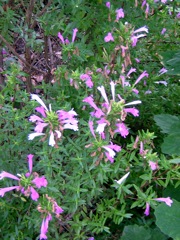
Mexican Oregano loves the summer heat!
Picture taken at The Herb Cottage
Here in my area of Texas, from mid summer until at least the end of September, it is very hot, humid and stressful for our plants, even the hardy herbs. (It’s stressful for the gardener, too… but that’s a topic for another discussion!)
One way to help our herbs survive the summer weather is to prune them back so they don’t have so much plant matter to keep hydrated. It is easier for the roots to deliver water to shorter stems and the plant stays looking healthier and prettier, too.
Herbs That May Need Pruning
Mints
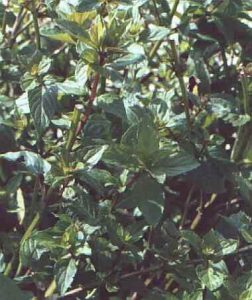
Healthy Peppermint Plant
Mints tend to become leggy by this time in the summer, unless you’ve really been using them a lot to keep their growth compact.
I find this is the perfect time of year to prune the mints back. The intense heat of late summer here in Texas is not kind to mints. So, I like to prune off the long growth and dry it for use in iced teas and allow the plant to put on new growth from the roots. This practice gives the plants some rest from having to pump so much water out to the ends of the stems during the hottest time of the year.
You can prune all the way to the ground, if you like. They’ll come back beautifully, provided you keep the plants watered.
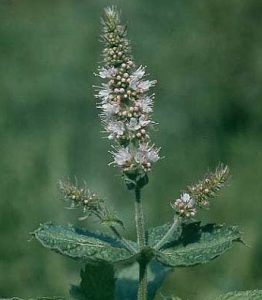
Mint Flower- don’t be afraid to let your mints flower. The flowers bring beneficial insects to your garden. Use the flowers in teas and drinks, too!
This is also a good time to divide your mints. Whether they’re growing in containers or in the ground, you can dig sections out or dig (or de-pot) the whole plant and see where new little sections have started themselves. Clip those off the main plant and replant or repot them. If you see brown or shriveled roots on the main part of the plant, prune those off, too. Then, repot or replant the main plant- or discard it if it looks tired or if the center of the plant has died out.
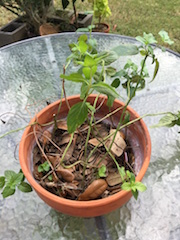
This mint need pruning! I’ll take it all the way to the soil line.
Just remember to keep all the plants watered well after pruning, transplanting or dividing and you’ll be rewarded with new growth in just a few weeks. Meanwhile, you have the dried mint for your tea.
Oregano/Marjoram
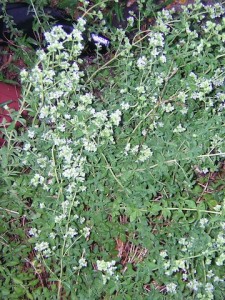
Blooming Greek Oregano. Picture taken at The Herb Cottage
By this time of year, my oregano and marjoram have flowered or are flowering. Since these are perennial plants, you can enjoy the flowers and leave them on until they are played out. Flowers from the oregano family bring beneficial insects to your garden and they are pretty. If you like, you can clip them for cut display or use them to flavor your cooking.
There are several types of oregano designated a ‘flowering oregano’ or ‘ornamental oregano’. These are cultivars that have been bred for their more dramatic flowers. Alas, some of the flavor has been lost from these types and they are best used as hardy ornamental landscape plants.
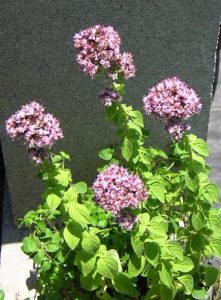
Blue Oregano. Not great flavor, but a striking plant when in bloom!
Whichever type of oregano you are growing, after the flowers fade, the plant doesn’t look its best. The stems can become leggy and the spent flowers are rather unattractive. So, now’s the time to prune the flower heads off. You can also prune the whole plant back if it’s gotten too big or needs shaping.
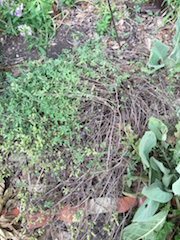
Terribly overgrown Greek Oregano. Lots of bare stems. I’ll prune to the soil level here and dry the leaves for use in the kitchen.
There is rule of pruning which says for best results, don’t prune more than about 1/3 of the growth of the plant. This is true for some plants, like a large Rosemary, roses and other shrubs. But, many herbs can be pruned all the way to the ground when they’ve gotten out of control. Which ones, you might ask? Here’s a list of some common herbs that can be pruned all the way to the ground, whether you’re growing in pots or in the ground:
- oregano
- marjoram
- mints
- lemon balm
- catnip
- chives/garlic chives
Basil
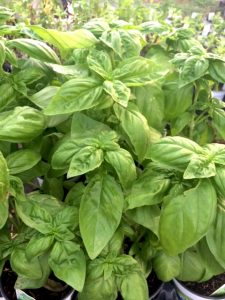
Fresh Basil in the garden.
Since basil is an annual, it has different characteristics from the previous plants I’ve mentioned. It flowers much more readily, as those of you who grow basil know.
We attempt to keep it from flowering by frequent harvesting. Once the plant gets older and the stem starts to become woody, the tops will begin to flower signaling that the plant is near the end of its annual cycle.
We can clip off flowers to maintain the leafy, succulent growth for a while, but eventually, the plant wants to flower, set seed and die out.
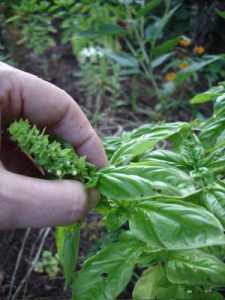
Here I’m pinching a young flower bud off a basil plant.
If you haven’t been harvesting your basil frequently and the plant still has leafy growth all along the stem, go ahead and prune the stems back, but not so far as to get into the woody growth, if you have that. It’s unlikely the plant will leaf out again if you prune back to the woody growth. By pruning into just the newer, soft wood, your basil will send out new branches and leaves for your next harvest.
It is best to harvest/prune your basil fairly frequently during its active growth. That way, you avoid getting those long stems that lose leaves along the stem and end up with just the fresh, new growth at the top. If your basil is very leggy with growth only at the top of the stems, it’s probably best to take it out and put in a new plant.
I am often asked if basil can be grown from cuttings. And, the answer is a resounding YES! The best time to take basil cuttings is in the early growth stages of the plant. I don’t mean when it’s very young and soft, but before it looks like it’s going to begin to flower.
Any cutting you stick and root is the same age as the plant you took it from. So, if the stem you’re rooting was about to flower when it was attached to the plant, it’s going to flower right away as a rooted cutting, too.
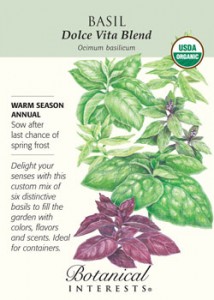
Basil Seed Blend sold here at The Herb Cottage
A packet or two (or three…) of basil seed is very inexpensive. Starting basil from seed is easy, and it’s easier as the weather warms up. So, if you’re really into basil or pesto, think about investing in some seed early in the season and every 3 or 4 weeks during the growing season, sow a few seeds for new plants. That way, when your older plants no longer look lush and lovely, you have new plants coming along to replace them with.
Lemon Balm
Another herb that usually needs pruning this time of year is lemon balm.
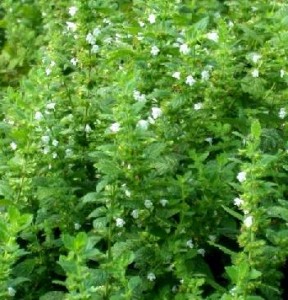
Lemon Balm in flower. After flowering, the plant can be pruned back to the ground if it looks leggy or stressed by heat.
After flowering, growth can get leggy and the heat can cause the leaves to look splotchy and brown. Just prune it to the ground and you’ll have lush, new growth in a few weeks. By Fall, your plant will be its old self again, ready for harvesting more of those lemony, soothing leaves for tea, cakes, quick breads and more.
Herbs that Don’t Need Pruning
Chives
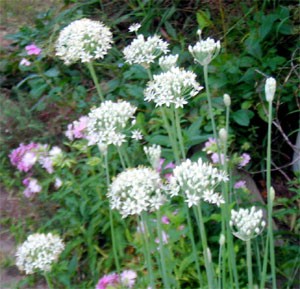
Garlic Chives in flower. These flower during the hottest time of the year! July & August.
Chives, including regular and garlic varieties rarely need pruning. Their growth habit is grass-like, so they never become leggy. If you harvest correctly by clipping the whole stalk just above the soil line, the individual stalk with grow out again and the clump will keep growing and putting out new stalks. If you harvest simply by grabbing a handful and ‘giving them a haircut’, you will not see as much new growth.
Definitely allow your chives to flower. Garlic chives bloom in July through August, the regular chives tend to bloom earlier in the summer- in June. You can use the flowers in vinegars and salads, too, just like the stalks.
Lemon Grass
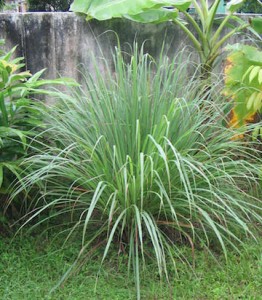
Healthy lemon grass plant.
Lemon Grass is another herb that doesn’t really need pruning. As with the chives, it’s best to harvest by clipping the whole stalk. In fact, with lemon grass, it’s usually the fleshy part near the soil line that’s used in cooking. The fleshy part is cut away from the leafy part and either minced or smashed to release the flavor.
Personally, I think the best way to use lemon grass is to add it to your dish in large pieces so you can remove it before serving the dish. It’s very tough and not meant to be eaten.
The leafy parts can be used for a light and flavorful tea. It dries well, too, so you can preserve it for use. I like it mixed with green tea for an aromatic and satisfying hot or iced tea.
Fennel
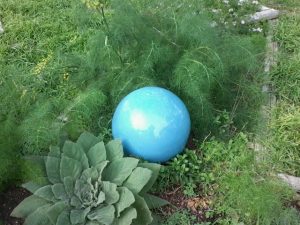
Soft Green Fennel with a Mullein plant in the foreground.
Fennel tends to be perennial here, so I just let it grow as it pleases. I get new stalks on a regular basis and it stays looking good. Sometimes I cut off the spent flower heads with the seed to keep for trades, baking and reseeding. Occasionally, there are dried branches that keep the plant from looking its best and I do prune those off if I have the clippers handy. Otherwise, my fennel just takes care of itself.
Oh.. it is a favorite of my garden visitor- a pesky gopher- and I find the whole plant toppled over with no root whatsoever, and I know the gopher has been in that herb bed. Apparently, gophers like fennel root, as well as parsley root. I grow most of my fennel now in large containers.
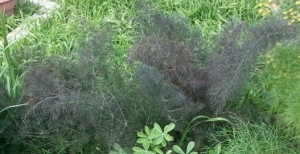
Bronze Fennel seems to stay more compact than the green type.
In most places in the country people look forward to summer to be outdoors tending their gardens, pruning, harvesting and keeping everything looking great. Here in Texas, by this time of year, much of our vegetable garden is finished- except for okra, eggplant, field peas (black eyes, crowder, lady creams, etc.) and hot peppers. Our herbs need pruning and most of the ornamental flowers we enjoyed in Spring are faded or gone.
It’s a time for the gardener to sneak out in the early morning and evenings to do a few things, then get in some shade with a cold drink and a good book, or back into the house where the AC is.
Taking some time now to prune and rejuvenate your herbs will give you a healthier and more productive plant in the fall as the days shorten and cool down. Don’t stress yourself in the heat. Take breaks to enjoy your herbal teas in the shade when you are outdoors.
Remember… even in Texas… summer doesn’t last forever!
QUOTE FOR THE MONTH
Since when do we have to agree with people to defend them from injustice?
-Lillian Hellman, playwright (20 Jun 1905-1984)
